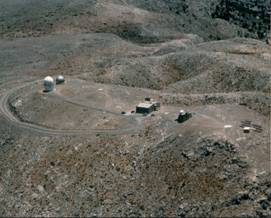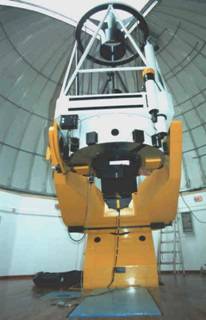The section of Astrophysics and Space Physics comprises of Professors V. Charmandaris, C. Haldoupis, N. Kylafis, I. Papadakis, I. Papamastorakis, V. Pavlidou, K. Tassis, I. Vardavas, and A. Zezas, as faculty, Drs. B. Agis-Gonzalez, J. Antoniadis, D. Blinov, V. Bonjean, C. Casadio, T. Diaz Santos, A. Gkogkou, I. Leonidaki, I. Liodakis, G. Maravelias, A. Paggi, E. Partington, F. Poetzl, P. Reig, M. Sánchez-García, D. Souropanis, N. Uppal and M. Zapartas as associated scientists, as well as a number of graduate students.
 Research in Astrophysics and Space Physics in Crete is both theoretical and observational and covers a broad range of subjects, ranging from studies of the Earth's atmosphere and ionosphere, to the study of distant galaxies. Within our Solar System, research is concentrated on the evolution of planetary atmospheres. Within our Galaxy, we study the properties of white dwarfs, neutron stars, black holes, planetary nebulae, andsupernova remnants. Beyond our Galaxy, areas of investigation include the star formation history and evolution of galaxies in the Local Group, the dust distribution and infrared properties of spiral, starburst and ultraluminous infrared galaxies, astronomical MASERs, jets and other exotic phenomena in active galactic nuclei and quasars.
Research in Astrophysics and Space Physics in Crete is both theoretical and observational and covers a broad range of subjects, ranging from studies of the Earth's atmosphere and ionosphere, to the study of distant galaxies. Within our Solar System, research is concentrated on the evolution of planetary atmospheres. Within our Galaxy, we study the properties of white dwarfs, neutron stars, black holes, planetary nebulae, andsupernova remnants. Beyond our Galaxy, areas of investigation include the star formation history and evolution of galaxies in the Local Group, the dust distribution and infrared properties of spiral, starburst and ultraluminous infrared galaxies, astronomical MASERs, jets and other exotic phenomena in active galactic nuclei and quasars.
The datasets used for our research are obtained from a variety of ground based optical telescopes including Skinakas Observatory as well as radio telescopes. Space-borne facilities, such as the Hubble Space Telescope in the optical, ROSAT, RXTE, CHANDRA, and XMM/Newton in the X-rays, and ISO, Spitzer, WISE, Herschel and JWST in the infrared are also being used.
Locally, the research activities of the section are mainly supported by the Skinakas Observatory.
The scientific impact of the section of Astrophysics and Space Physics, as quantified by the number of publications in international refereed journals, is approximately 40 publications per year. The annual report of the section is available online for the period 1993-1997, as well as for the calendar years 2004, 2005, 2006, 2007, 2008, 2009, 2010, 2011, 2012, 2013, 2014, 2015, 2016, 2017 and 2018. Due to the founding of the Institute of Astrophysics of the Foundation for Research and Technology - Helas (IA-FORTH) in 2018 and the retirement of Prof. Vardavas and Prof. Haldoupis, all activities of the astrophysics faculty are since presented in the Annual Reports of IA-FORTH.
A brief description of some of the research projects underway follows:
 Research in Theoretical Astrophysics includes:
Research in Theoretical Astrophysics includes:
-
Study of the physics of strong magnetic fields in stellar objects, such as pulsars, and neutron stars.
-
Study of radiative processes, radiative transport and formation of spectral features in white dwarfs, neutron stars and pulsars.
-
Study of accretion phenomena onto neutron stars and black holes in binary stellar systems.
-
Investigation of gamma-ray burst sources.
-
Modeling of astronomical objects and transfer of radiation of all wavelengths in various astronomical environments. Specific objects of research are: X-ray sources (white dwarfs, neutron stars, black holes), Astronomical MASERs, Spiral galaxies.
Research in ionospheric physics includes:
-
Investigation of coherent radio wave backscatter phenomena from magnetic aspect-sensitive plasma waves in the E region ionosphere, Ionospheric plasma irregularities, and instabilities.
-
Μidlatitude sporadic E-layers, formation and motions, plasma instabilities, E/F region electrodynamic coupling. Interaction of Mesosphere Lower Thermosphere (MLT)dynamics, winds, and waves (gravity, tidal and planetary waves), with sporadic E layer plasma.
-
VLF detection and modeling of ionospheric effects caused by thunderstorms in the lower ionosphere, VLF signatures of transient luminous events (TLEs: sprites, elves, and gigantic jets). X-ray solar flare effects on the ionosphere. Atmospheric global electric circuit studies.
Research in Earth's and planetary atmospheres includes: studies of the evolution of the atmosphere and the Earth and various planets of our Solar System using computer simulation models of atmospheric composition, radiation field and thermal structure. These models generate the vertical structure of the atmosphere's temperature and the concentrations of its molecular constituents. The research fields include:
-
The evolution of the earth's climate in relation to solar and geological evolution.
-
The structure and evolution of the atmospheres of Titan and Mars.
-
The calculation of the energy budget of the Earth's surface/atmosphere.
-
Climate change studies.
-
Sustainable water resource exploitation, in particular in Crete and the Mediterranean Basin.
Research in Observational Astrophysics includes:
-
Study of the morphology and chemical composition of Supernova Remnants and Planetary Nebulae (using observations through narrow band interference filters and spectrophotometry), with the aim of better understanding the emission processes and the last stages of stellar evolution (e.g., detection of extended halos in planetary nebulae resulting from stellar winds).
-
Study of X-ray binary systems, consisting of a compact object orbiting a normal star.
-
Study of the optical properties of Active Galactic Nuclei (AGNs)
-
Study of the X-ray emission properties of Active Galactic Nuclei (both their energy spectrum and their variability properties). Study of the optical band variability properties of both radio-loud AGN (ie BL-Lacs) and radio-quiet AGN (such as Seyfert 1s and high redshift quasars) with the aim of better understanding the physical mechanism of their variability.
-
Study of the distribution of dust in spiral galaxies, with the ultimate purpose of understanding star formation processes and galactic evolution.
-
Study of the infrared properties of ultraluminous infrared galaxies, starburst, and AGN, in order to understand the physics of the dominant mechanism for the energy production in their nuclei.
-
Studying the effects of the environment in the evolution of interacting galaxies.
-
Study of the cosmological implications of distant normal and infrared luminous galaxies based on their infrared properties and the observed number counts in deep surveys.
More information on our activities can be found in the web page of the Institute of Astrophysics at FORTH.
Last Update: 6 April 2025, 19:41:04




